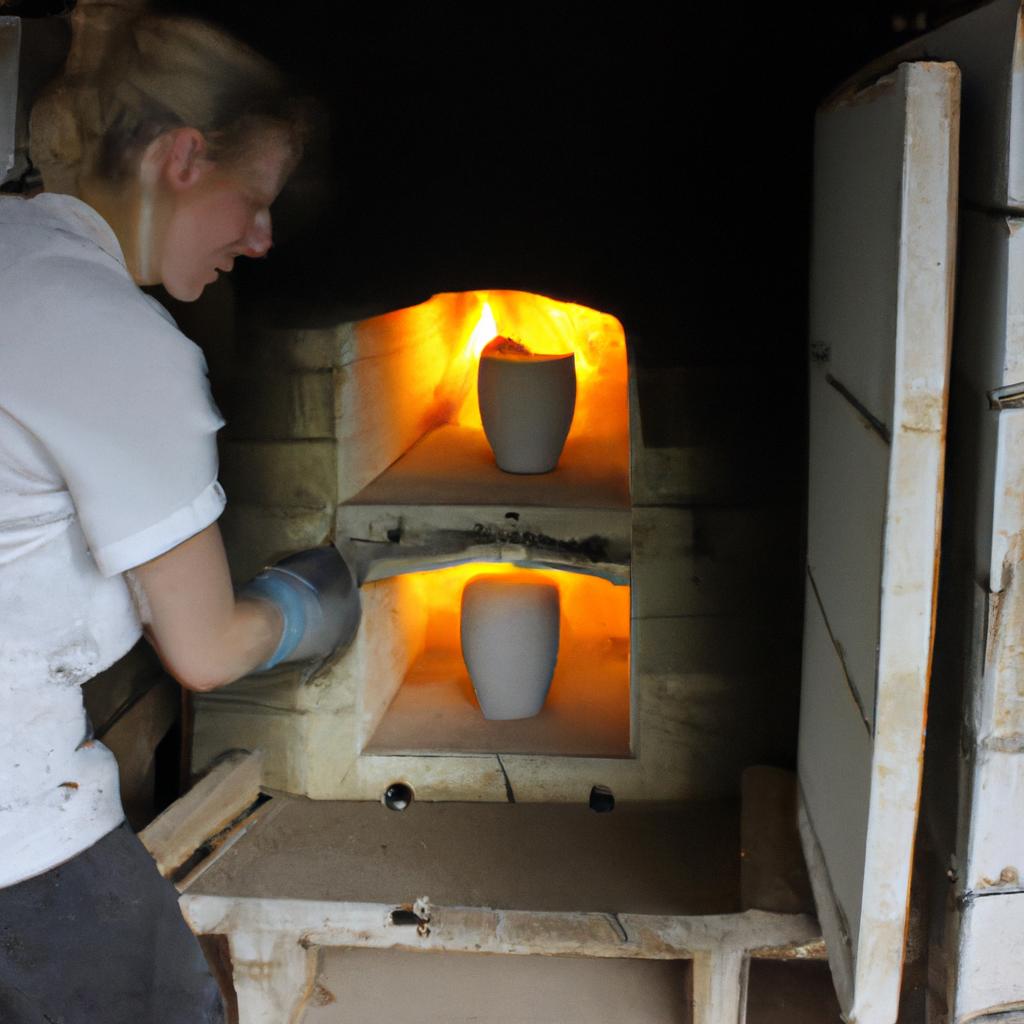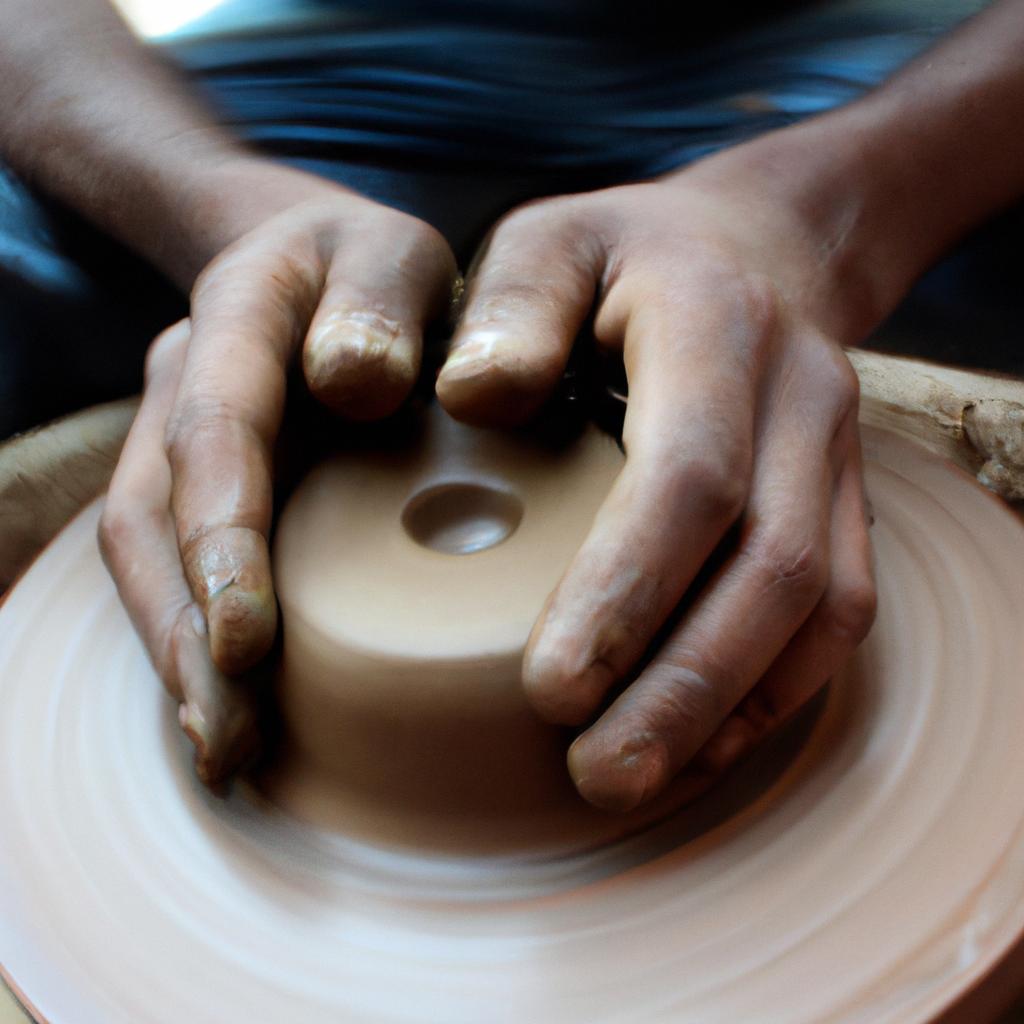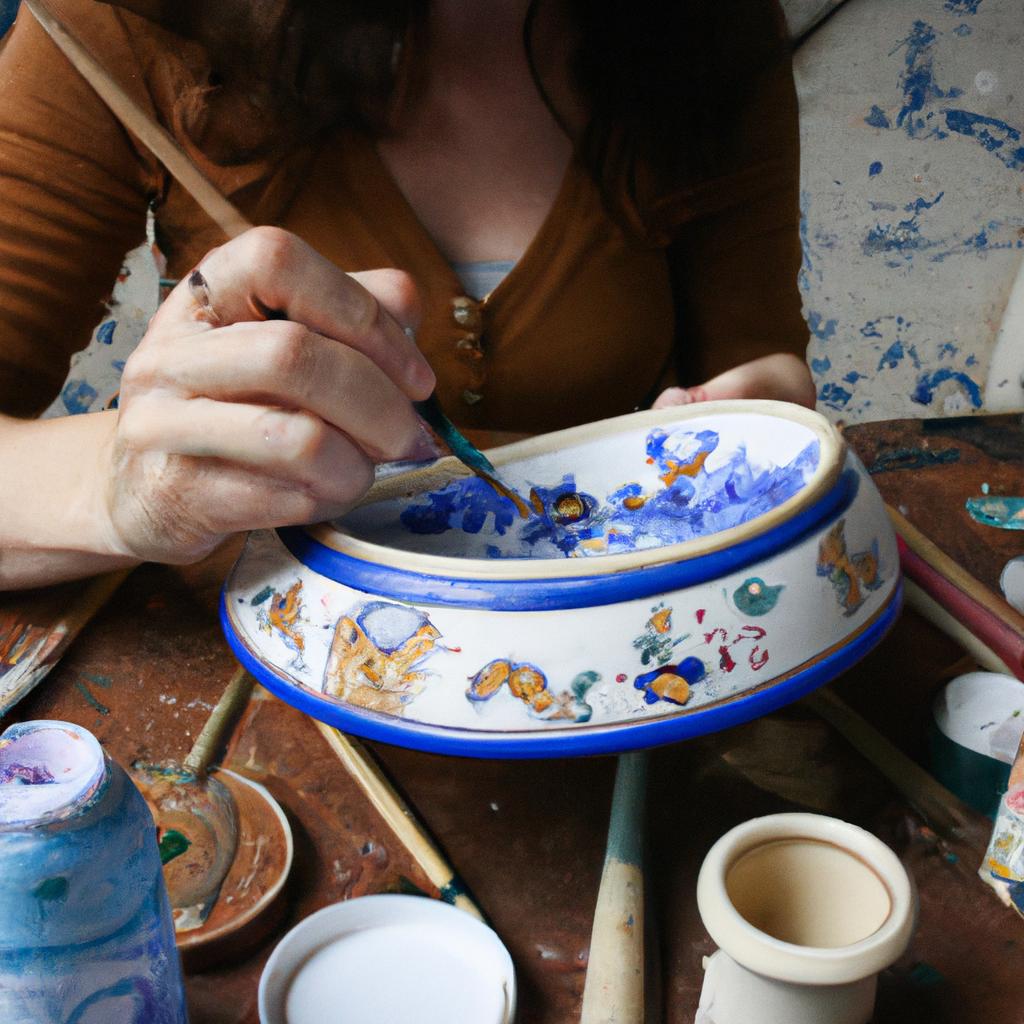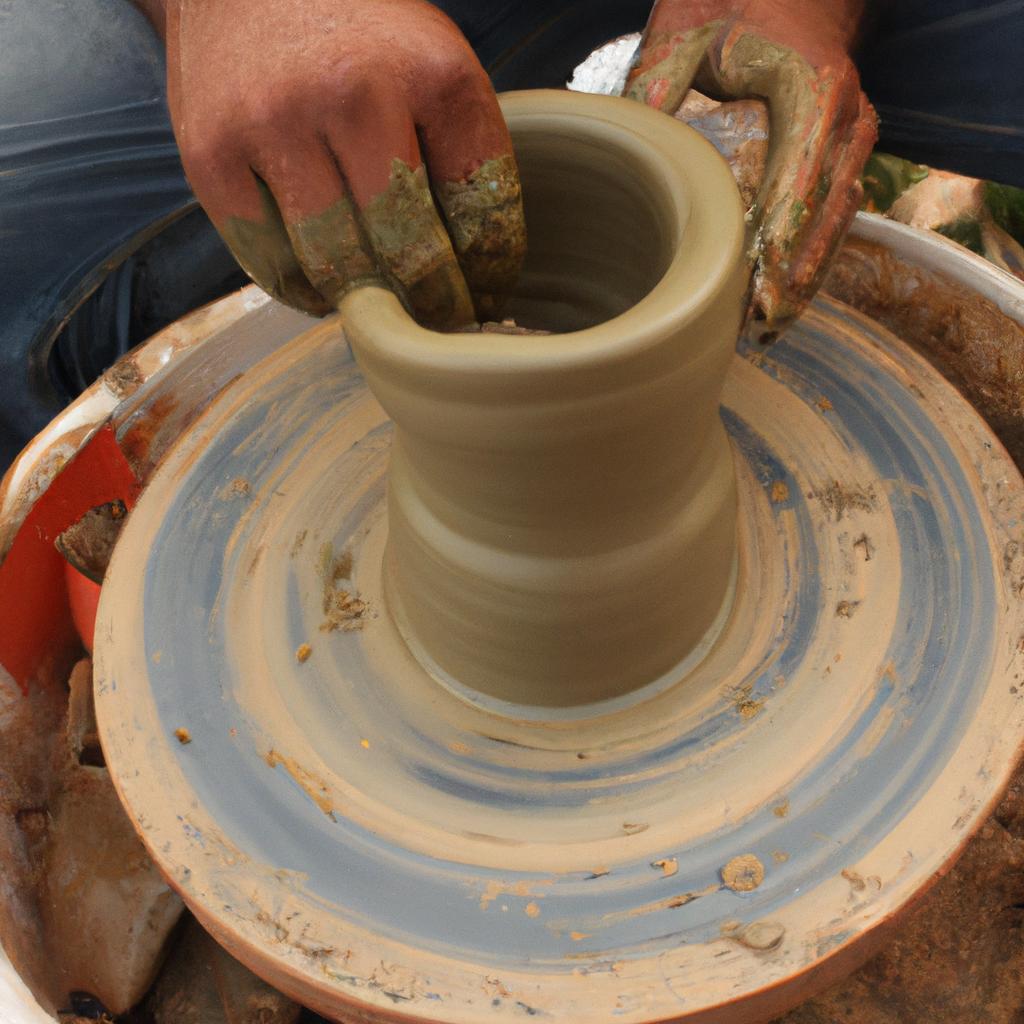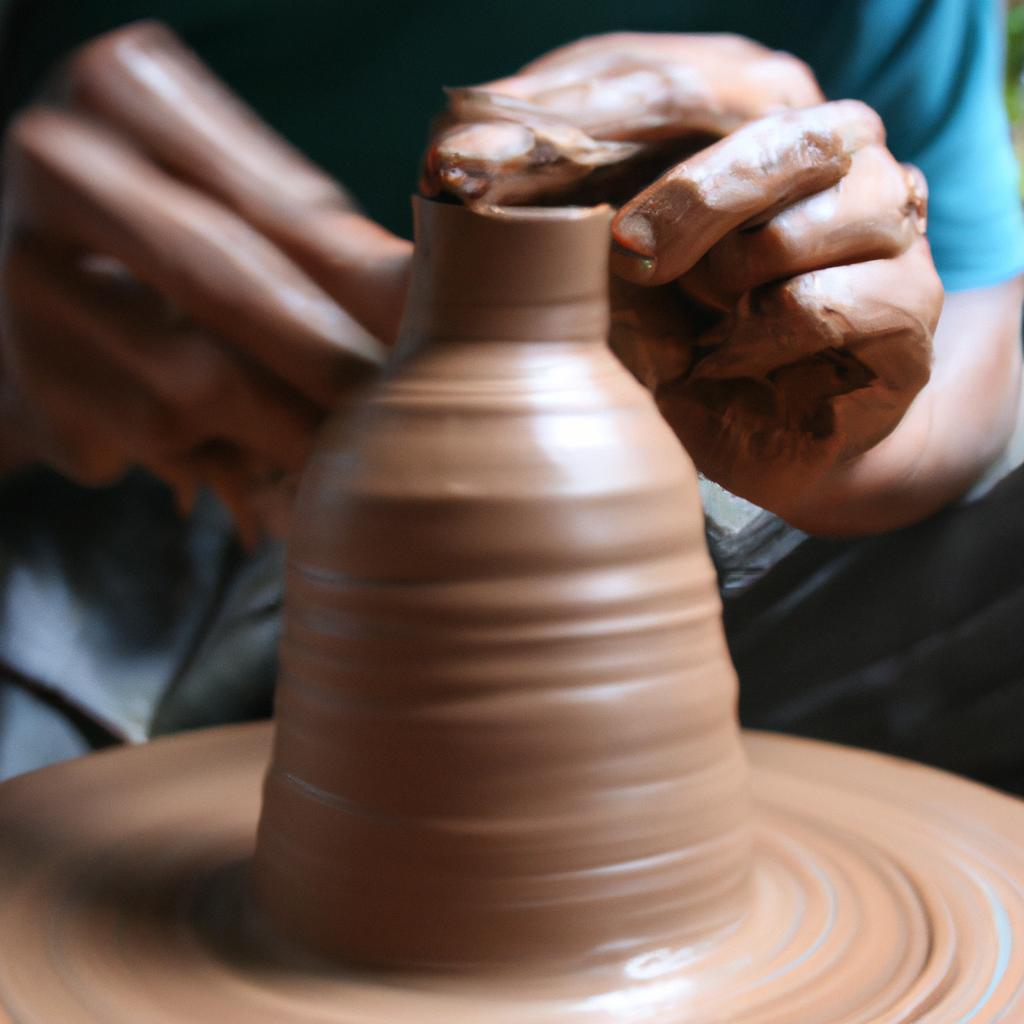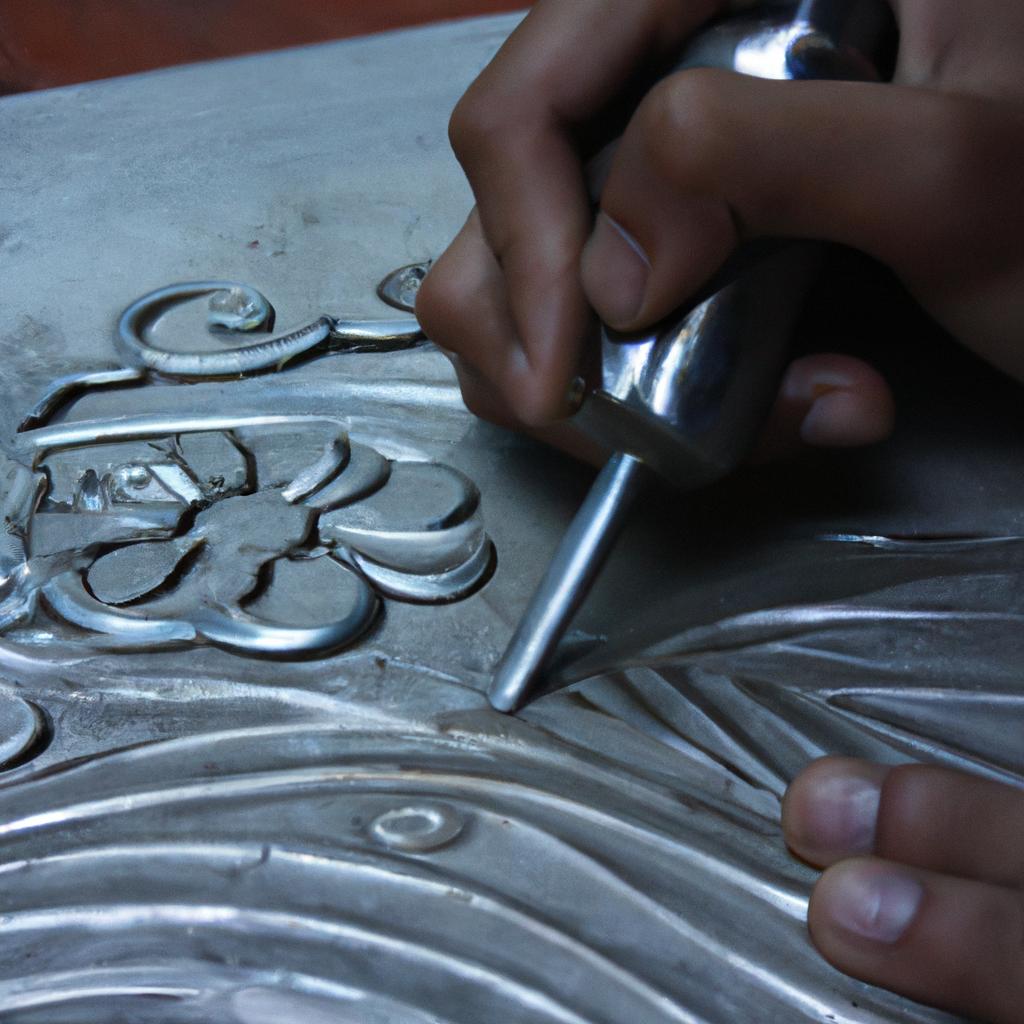Glazing Methods in Visual Arts: A Ceramics Overview
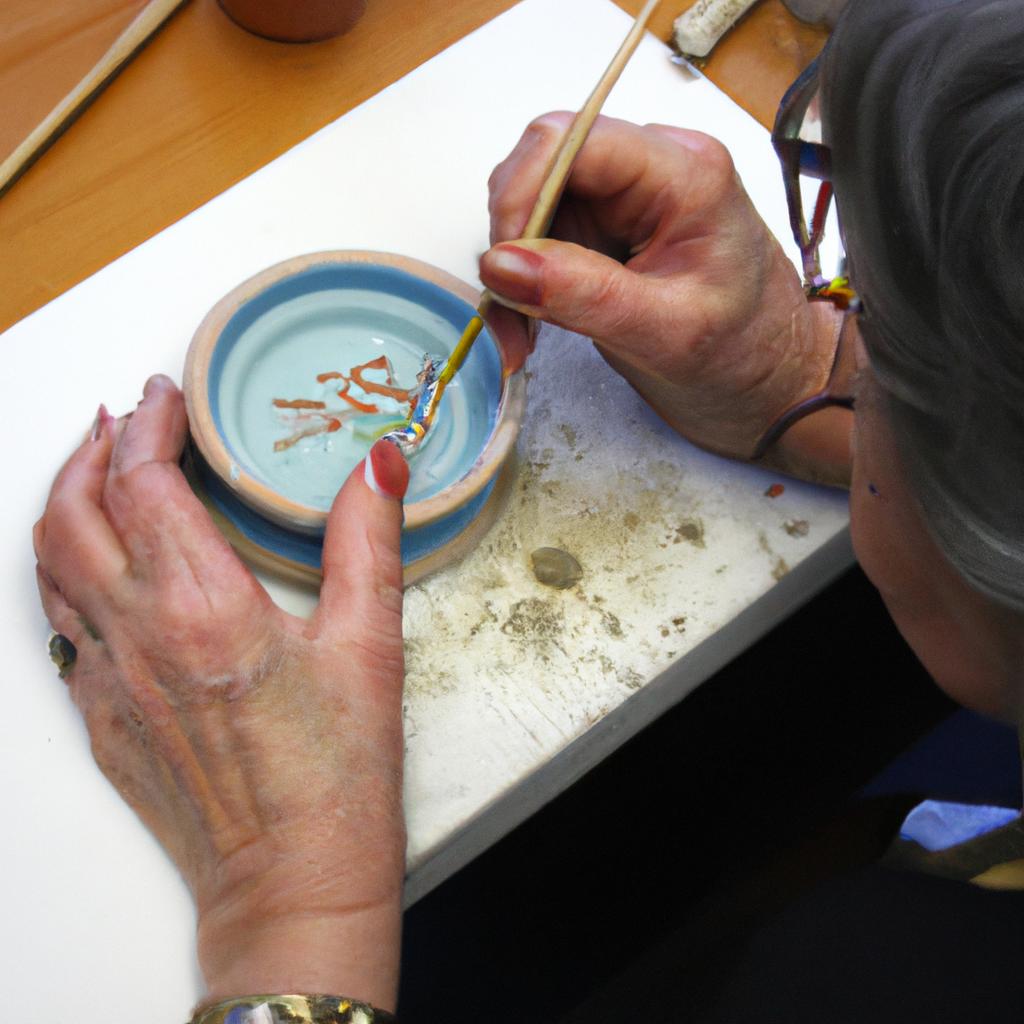
Glazing methods play a crucial role in the world of visual arts, particularly in the realm of ceramics. The application of glazes not only enhances the aesthetic appeal of ceramic artworks but also provides durability and protection to the underlying surfaces. This article aims to present an overview of various glazing techniques employed by artists in ceramics, shedding light on their unique characteristics and applications.
Consider, for instance, a hypothetical case study where a ceramic artist seeks to create a visually striking vase with intricate patterns. In order to achieve this desired outcome, they must carefully select and employ suitable glazing methods. By understanding the different types of glazes available – such as transparent, opaque, matte, or glossy – along with their respective firing temperatures and chemical compositions, the artist can manipulate their results effectively. Furthermore, exploring alternative approaches like raku firing or salt-firing may offer additional avenues for artistic expression through unexpected effects and textures.
History of Glazing in Art
Glazing, the process of applying a thin layer of glass-like material to ceramics, has been an integral part of artistic expression for centuries. One notable example that exemplifies the transformative power of glazing is the case study of Chinese Tang Dynasty pottery. During this period (618-907 AD), artisans developed a technique called sancai, which involved using three distinct colors – green, yellow, and white – to create intricate patterns on ceramic vessels. This innovative use of glazes not only enhanced the aesthetic appeal of these works but also provided invaluable insights into the cultural and socio-economic context of the time.
To further comprehend the significance and impact of glazing as an art form throughout history, it is crucial to explore its emotional resonance with audiences. A bullet point list can effectively capture some sentiments associated with glazed ceramics:
- Beauty: The vibrant hues created by glazes captivate viewers, invoking feelings of awe and admiration.
- Durability: Glazed surfaces protect ceramics from wear and tear, ensuring their longevity and allowing future generations to appreciate their beauty.
- Versatility: Different types of glazes offer artists endless creative possibilities, enabling them to achieve various textures, finishes, and effects.
- Cultural Significance: Glazed ceramics often hold symbolic meaning within specific cultures or periods, offering glimpses into societal values and beliefs.
Moreover, visual representation through tables adds depth to our understanding when examining historical developments. Consider the following table showcasing significant milestones in the evolution of glazing techniques:
| Period | Technique | Characteristics |
|---|---|---|
| Ancient Egypt | Faience | Vivid blue-green color reminiscent of precious stones |
| Islamic Empire | Lusterware | Metallic sheen achieved through additional firing processes |
| Italian Renaissance | Maiolica | Opulent decoration featuring intricate designs |
| Contemporary | Raku | Unpredictable, often dramatic results due to rapid cooling |
In summary, the historical significance of glazing in art cannot be overstated. The case study of Tang Dynasty pottery exemplifies how glazes can elevate ceramic creations and provide invaluable cultural insights. By evoking emotions such as beauty, durability, versatility, and cultural significance, glazing continues to captivate audiences today. In the subsequent section on “Different Glazing Techniques in Ceramics,” we will delve into a detailed exploration of various methods artists employ to achieve stunning glazed effects.
(Note: Transition into next section) Continuing our exploration of glazing techniques in ceramics…
Different Glazing Techniques in Ceramics
Transitioning from the previous section on the history of glazing in art, we now delve into the different glazing techniques employed in ceramics. To better understand these methods, let us consider a hypothetical case study of an artist who creates unique ceramic vessels using various glazing approaches.
One notable technique is called dipping, where the artist immerses their pottery piece into a vat of glaze to achieve an even and consistent coating. This method allows for precise control over the application thickness and can create captivating effects when multiple layers of different glazes are combined. In our case study, imagine a potter skillfully dipping her delicate porcelain vase into a pool of vibrant blue glaze, resulting in a mesmerizing gradient effect that captivates viewers.
Apart from dipping, another widely used technique is brushing. With this approach, artists apply glaze onto their ceramics using brushes of varying sizes and bristle types. The brushstroke patterns left behind by this method contribute to the uniqueness and charm of each artwork. Consider our case study once again, envisioning an artist meticulously layering thin strokes of metallic gold glaze onto a stoneware plate, creating intricate designs reminiscent of ancient civilizations.
Additionally, spraying offers yet another dimension to glazed ceramics. By utilizing compressed air or spray guns loaded with diluted glazes, artists can achieve thin and even coats while also experimenting with gradients and texture variations. Let your imagination explore our case study further as you picture an innovative ceramist confidently applying misty layers of translucent green glaze onto her sculptural vessel through a fine nozzle sprayer.
To fully appreciate the diverse range of techniques available to artists working with ceramics, here is a bullet point list showcasing some emotional responses that can be evoked through specific combinations:
- Delicate brushstrokes evoke nostalgia
- Bold splatters convey energy
- Smooth gradients elicit tranquility
- Textured surfaces inspire curiosity
Moreover, let us explore a table that highlights the characteristics of each glazing technique:
| Technique | Application Method | Resulting Effect |
|---|---|---|
| Dipping | Immersion in Glaze | Even coating |
| Brushing | Applied with Brushes | Unique brushstroke patterns |
| Spraying | Applied through Spray Guns | Thin and even coats, texture variations |
As we conclude this section on glazing methods in ceramics, it is evident that artists have an array of techniques at their disposal to bring forth distinct artistic expressions. In our subsequent section about “Glaze Composition and Application,” we will delve into the fundamental aspects of crafting glazes and explore how they can further enhance ceramic artworks.
Looking beyond the application methods, understanding the composition and application of glazes plays a crucial role in achieving desired results.
Glaze Composition and Application
Glazing Methods in Visual Arts: A Ceramics Overview
Different Glazing Techniques in Ceramics explored various methods used to achieve different glaze effects on ceramic surfaces. Now, we will delve further into the composition and application of glazes, shedding light on how artists create unique finishes through their artistic process.
To illustrate this, consider a hypothetical case study where an artist aims to create a crackled effect on a ceramic vase using a high-temperature glaze. This technique involves applying multiple layers of glaze with contrasting expansion rates. As the piece is fired in the kiln, the differing rates cause stress within the layers, resulting in fine cracks across the surface.
When it comes to selecting or formulating glazes for specific outcomes, there are several factors that artists must take into consideration:
- Color: Artists carefully choose pigments and oxides to achieve desired hues. Each colorant reacts differently under varying firing temperatures and atmospheric conditions.
- Texture: The texture of a glaze can range from glossy to matte and crystalline to rough. Artists experiment with ingredients such as feldspar and silica to manipulate these characteristics.
- Durability: Depending on its intended use, a ceramic piece may require enhanced durability. Glazes formulated with additional materials like alumina or boron can increase resistance to wear and tear.
- Toxicity: Safety is paramount when working with ceramics; therefore, artists need to be mindful of any potentially toxic elements present in their chosen glazes.
In understanding the different aspects involved in crafting noteworthy glazed pieces, it becomes evident that meticulous attention is required throughout the entire process – from formulation to application.
Moving forward, we will explore Firing and Kiln Techniques in Glazing, which play an integral role in transforming raw clay into stunning works of art without compromising the integrity of intricate glazed designs created by skilled artisans.
Firing and Kiln Techniques in Glazing
Transitioning from the previous section on glaze composition and application, understanding the firing and kiln techniques is crucial for achieving desired results in ceramics. Let us delve into this aspect further by examining a case study involving a ceramic artist who sought to enhance the vibrancy of their glazed pottery.
Consider an artist named Sarah, who wanted to create a series of mugs with vibrant colors using different types of glazes. After applying various glaze compositions onto her pottery, she needed to carefully consider the firing process to ensure optimal outcomes.
One important factor in firing is temperature control, as it directly affects the transformation of glazes during the heating process. Different types of glazes have specific firing temperatures that allow them to mature correctly. For instance, high-fire stoneware glazes typically require higher temperatures ranging from 1200°C to 1300°C (2192°F – 2372°F), while low-fire earthenware glazes can be fired at lower temperatures around 900°C (1652°F). Understanding these temperature requirements is essential for achieving consistent and predictable results.
Additionally, the duration of firing plays a significant role in determining the final appearance of glazed ceramics. Prolonged or rapid firings can lead to undesirable effects such as bubbling or blistering on the surface of the glaze. Sarah learned that following recommended firing schedules provided by manufacturers helped maintain consistency and prevented potential issues.
To summarize, when exploring firing and kiln techniques in ceramics, artists must consider both temperature control and duration. By adhering to appropriate firing schedules based on glaze type, they can achieve desired results without compromising their work’s integrity.
Emotional Bullet Point List
- Achieving perfectly fired ceramics requires meticulous attention to temperature control.
- The choice between high-fire and low-fire techniques impacts not only visual appeal but also physical properties like durability.
- Proper firing techniques can make or break the success of a glaze, affecting its color, texture, and overall aesthetic.
- Mastery of kiln firing empowers artists to bring their creative visions to life with precision.
Emotional Table
| Firing Technique | Temperature Range (°C) | Advantages |
|---|---|---|
| High-fire | 1200°C – 1300°C | Vibrant colors, durable finish |
| Low-fire | Around 900°C | Varied surface effects, quicker turnaround time |
| Raku | Below 1000°C | Unique crackle patterns, smoky finishes |
| Pit-firing | Varies | Organic textures, unpredictable results |
Transitioning from firing and kiln techniques in glazing, we will now explore the captivating world of glazing effects and surface decoration. Understanding how different techniques can transform ceramics into visually stunning works of art allows artists to infuse their pieces with individuality and expressive flair.
Glazing Effects and Surface Decoration
Building on the knowledge of firing and kiln techniques explored in the previous section, this next section delves into the captivating realm of glazing effects and surface decoration. By exploring various methods artists employ to achieve unique finishes, we can gain a deeper understanding of how glazes contribute to the overall aesthetics of ceramic artworks.
Glazing Effects:
To illustrate the diverse range of possibilities with glazing effects, let us consider an example where an artist seeks to create a metallic finish on a vase. In this case, they may choose to use luster glaze, which contains metal oxides that produce iridescent hues when fired at specific temperatures. This technique adds depth and visual interest by mimicking precious metals such as gold or silver.
Surface Decoration Techniques:
Artists often combine different decorative techniques with glazes to enhance their artistic vision. Some popular methods include sgraffito, mishima, and marbling:
- Sgraffito: This ancient technique involves scratching through layers of contrasting colors to reveal intricate designs or patterns beneath.
- Mishima: Originating from Korea, this method entails incising lines or shapes onto leather-hard clay before filling them with colored slip.
- Marbling: Artists achieve stunning marble-like effects by layering multiple colors of thin liquid clays or engobes and manipulating them using various tools.
Table: Emotional Response – Glazing Methods
| Method | Description | Effect |
|---|---|---|
| Luster glaze | Creates iridescent hues | Evoke a sense of opulence and luxury |
| Sgraffito | Reveals intricate designs through scratched lines | Captivate attention with detailed artwork |
| Mishima | Fills incised lines for added texture | Enhance tactile experience |
| Marbling | Mimics elegant marble patterns | Inspire awe with visually striking aesthetics |
Contemporary Trends in Glazing:
As artists constantly push the boundaries of their craft, glazing techniques have evolved to embrace contemporary trends. From experimental approaches that incorporate unconventional materials like glass shards or metal filings into glazes, to innovative firing methods such as raku and saggar firing, today’s ceramicists continue to explore new possibilities for surface decoration.
With a solid foundation on the fundamental aspects of glazing now established, we can delve further into these exciting contemporary trends in the subsequent section
Contemporary Trends in Glazing
Glazing Effects and Surface Decoration play a crucial role in ceramics, allowing artists to enhance the visual appeal of their works. In the previous section, we explored various techniques used in glazing for achieving different effects. Now, let us delve deeper into some specific methods employed by ceramicists, examining their application and impact on the overall aesthetic.
One notable example is the technique known as “Mishima.” This method involves incising designs or patterns onto the surface of a clay vessel and filling them with colored slip before applying a transparent glaze. The result is a visually striking piece that showcases intricate details through contrasting colors. For instance, imagine an elegant vase adorned with delicate floral motifs carved into its surface and filled with vibrant red slip, creating a captivating contrast against the glossy white glaze.
When discussing glazing methods in ceramics, it is essential to consider both artistic intent and technical aspects. Here are four key factors that influence the selection and execution of glazing techniques:
- Firing temperature: Different types of glazes require specific firing temperatures to achieve desired results.
- Glaze compatibility: Some combinations of clays and glazes may react unpredictably during firing, leading to undesirable outcomes.
- Application tools: Artists utilize brushes, sprayers, sponges, or even fingers to apply glazes effectively.
- Layering techniques: By layering multiple coats or combining various types of glazes, artists can create unique visual effects such as depth or texture.
| Factor | Description | Example |
|---|---|---|
| Firing Temperature | Determines how high or low temperatures need to be set for successful firing | Using a matte black stoneware clay body requires higher temperatures than using porcelain |
| Glaze Compatibility | Understanding which combinations of clays and glazes produce desired results | Applying an iron-rich glaze to a clay body with high levels of manganese can cause unwanted chemical reactions, resulting in discoloration |
| Application Tools | The tools used for applying glazes influence the final appearance and texture | Using a sponge creates smoother, more even layers compared to using a brush |
| Layering Techniques | Different layering techniques allow artists to create various visual effects such as depth, texture, or subtle color variations | Applying thin washes of different colored glazes over each other can result in vibrant overlapping hues |
By considering these factors when choosing and implementing specific glazing methods, ceramicists can achieve their intended artistic outcomes effectively. Through meticulous selection of firing temperatures, understanding compatibility between clays and glazes, utilizing appropriate application tools, and experimenting with layering techniques, artists have limitless possibilities for creating captivating glazed ceramics.
In summary, this section discussed the importance of Glazing Effects and Surface Decoration in ceramics by examining specific methods employed by ceramicists. By incorporating examples like Mishima technique and highlighting four key factors that influence glaze selection and execution—firing temperature, glaze compatibility, application tools, and layering techniques—we gain insights into the intricate artistry behind successful glazed ceramics. Artists who skillfully navigate these aspects unlock endless possibilities for creating visually stunning works that captivate viewers’ attention.

